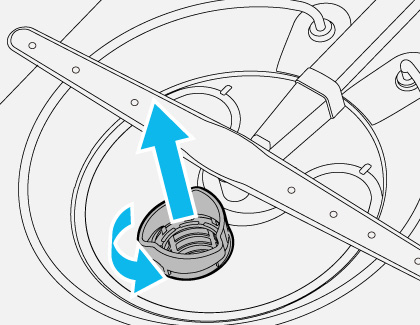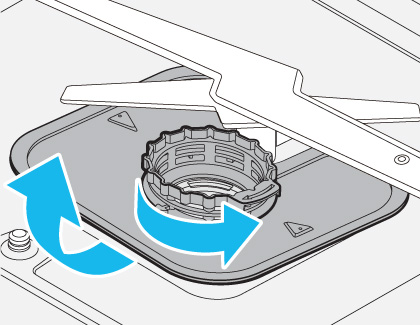Routine and deep clean your Samsung dishwasher

Routine and deep clean your Samsung dishwasher
Clean the exterior and interior
Clean the exterior

To clean the exterior, gently wipe down the outside of the dishwasher and control panel with a soft, damp cloth to remove any stains.
Clean the interior walls
One way to clean the interior is to place an 8 ounce cup of distilled white vinegar upright in the lower basket, and then run a Sanitize cycle by selecting the Sanitize button. (The Sanitize feature is not available when running Delicate and Rinse Only cycles.) This cycle will reach 163°F during the final rinse cycle for optimal sanitization.
Many models of dishwasher also have a Self Clean cycle that you can use as well. To check if your model has this cycle and instructions on how to run it if it does, see your user manual, available by searching for your model in our download center.
Clean the rest of the interior
Here's a tip: Rinse your dishes before you put them in the dishwasher!
Rinsing your dishes of the biggest food debris before putting them in the dishwasher can help prevent the filter and drain area from needing cleaning as frequently.
Have an odor problem? White vinegar is your friend.
In addition to the sanitize cycle mentioned before, removable parts like nozzles (and filter and drain pump, if they are removable on your model) can be soaked overnight in white vinegar to help clear them of mineral deposits and grime that could be causing an odor. If that alone doesn't help, see our other guide specific to that issue.
Deep clean

Before deep cleaning your dishwasher, you may want to perform a routine cleaning first by following the suggestions in the previous section.
- For a deep clean, remove the nozzles and filter. They should be soaked overnight in distilled white vinegar.
- Distilled white vinegar will remove mineral deposits and grime that have accumulated or are causing an odor.
Clean the nozzles
Nozzles should be cleaned regularly to ensure they can rotate smoothly and spray water through each of their holes. If any of the nozzles' holes are clogged, this reduces cleaning performance and can leave food particles on dishes.

- Remove any racks that are blocking access to the nozzle.
- Unfasten the nozzle cap by turning it counterclockwise, and then remove the upper nozzle. Some nozzles don't have a nozzle cap and can be pulled off.
- Clean the nozzle thoroughly using a small brush (such as a dishwashing brush or an old toothbrush). Allow the nozzle to soak overnight in distilled white vinegar, and then rinse it by running water through the nozzle. Make sure water can easily pass through all of the nozzle's holes.
- Reinsert the nozzle, and then fasten the nozzle cap (if it has one) by turning the cap clockwise. Afterwards, check whether the nozzle is attached correctly by rotating it.
Not your model?
The steps here are the most common and apply to many models, but if they don't match yours, then refer to your user manual for instructions specific to your model. Your user manual can be found by searching for your model in our download center.
Clean the filter
It is recommended that you keep the filter and drain area clean, and clean it whenever debris accumulates. This will correct clogged filter errors like 1E (which may look like IE), and can also help prevent other issues before they happen, like drain errors or odor.
The following steps cover multiple filter variants. If none of the variants listed here match your model, refer to your user manual for the correct steps, available by searching your model in our download center.
If your filter is removable, then your drain pump may also be removable, so make sure to also clean that if applicable while your filter is removed (see the drain pump section for details).
Proper assembly required
After cleaning, the filter must be reassembled correctly, or it may cause errors and other issues on the dishwasher, like drain or overflow issues.
Here's a tip: Rinse your dishes before you load them!
Rinsing your dishes of the biggest food debris before putting them in the dishwasher can help prevent the filter and drain area from needing cleaning as frequently.
Models with a fine filter

Some dishwashers come with a fine filter that helps provide extra protection. You will need to remove the filter insert and the fine filter and clean them both.
- Turn off the dishwasher, and then open the door.
- Rotate the filter counterclockwise to unfasten it, and then detach the filter.

- Remove the filter by lifting it upward.
Note: The fine filter is usually flat and includes a layer of mesh to help catch debris.

- Remove dirt or other debris from the filter, and then rinse it in running water. You can use a toothbrush to gently scrub away debris.
- Reassemble the filter in the reverse order, starting with the filter insert. Then, rotate it clockwise until it is locked.

Models with a micro filter

- Turn off the dishwasher, and then open the door. Remove the lower rack.
- Turn the filter handle counterclockwise to unlock the filter cover, and then remove the filter cover. Next, remove the cylindrical micro filter from underneath.

- Remove dirt and impurities from the micro filter and the filter cover. Rinse the micro filter and filter cover in running water. You can use a toothbrush to gently scrub away debris.
- Thoroughly dry both items before proceeding to the next step.
- Reinsert the filter and then reinsert the filter cover. Turn the filter handle clockwise to lock it.

Models without a removable filter

- Since the filter cannot be removed, thoroughly wipe down the dishwasher's interior everywhere that can be reached, including the drain area. Use a wet dishcloth to wipe away food particles or debris.
- Next, fill the detergent dispenser with dish detergent, and then run the dishwasher while it is empty using a Normal cycle (or Quick cycle if it is available).
- As long as the dishwasher is able to drain, this process will help clear away any remaining debris.
Clean the drain pump

On some dishwasher models, the drain pump can be reached when the drain filter is removed. If debris is caught in the drain pump, it can cause the dishwasher to make a noise or not drain properly.
If any debris has made it past the filter into this area, the drain pump should be removed and cleaned.
Not every model has a removable drain pump. If your model does, then steps for cleaning it will be in your user manual (mentioned in the table of contents). If it's not in the table of contents, your model does not have a removable drain pump.
You can find your user manual by searching your model in our download center.
Proper assembly required
After cleaning, the drain pump (and filter) must be reassembled correctly. If it is missing or incorrectly installed, it may cause errors and other issues on the dishwasher, like drain or overflow issues.
Contact Samsung Support


-
Mobile 8 AM - 12 AM EST 7 days a week
-
Home Electronics & Appliance 8 AM - 12 AM EST 7 days a week
-
IT/Computing 8 AM - 12 AM EST 7 days a week
-
Text Support 24 hours a day 7 days a week

You Are About To Be Redirected To Investor Relations Information for U.S.
Thank you for visiting Samsung U.S. Investor Relations. You will be redirected via a new browser window to the Samsung Global website for U.S. investor relations information.Redirect Notification
As of Nov. 1, 2017, the Samsung Electronics Co., Ltd. printer business and its related affiliates were transferred to HP Inc.For more information, please visit HP's website: http://www.hp.com/go/samsung
- * For Samsung Supplies information go to: www.hp.com/go/samsungsupplies
- * For S.T.A.R. Program cartridge return & recycling go to: www.hp.com/go/suppliesrecycling
- * For Samsung printer support or service go to: www.hp.com/support/samsung
Select CONTINUE to visit HP's website.





